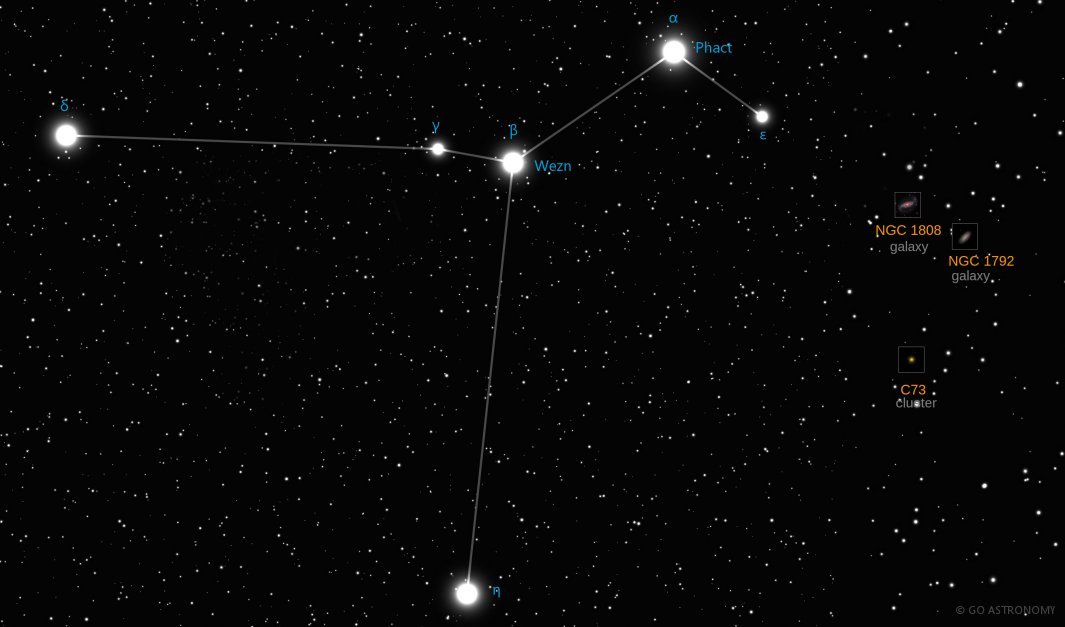Columba, the Dove (Col)
(cuh-LUM-buh)
The Southern constellation of Columba, the Dove, is best viewed in Winter during the month of February.
Columba is the 54th largest constellation. It's brightest star is Phact at magnitude 2.65. The boundary of the Columba constellation contains 3 stars that host known exoplanets.
- Pronunciation:
- cuh-LUM-buh
- Meaning:
- Dove
- Genitive:
- Columbae
- Abbreviation:
- Col
- Constellation Family:
- Heavenly Waters
- Hemisphere:
- Southern
- Quadrant:
- SQ1
- Visibility:
- 45° N - 90° S
- Best viewing month*:
- February
- Area:
- 270 sq. degrees
- Size:
- 54th largest
- Right Ascension (avg):
- 5h 42m
- Declination (avg):
- -36°
- Brightest star:
- Phact (2.65)
- Stars with planets:
- 3
- X-ray stars:
- 2 (binary) stars
- Messier objects:
- |
Brightest Stars in Columba
The 10 brightest stars in the constellation Columba by magnitude.
- Star
- Magnitude
- Spectral class
- Alpha Columbae (α Col)
- 2.65
- B7IV
- Beta Columbae (β Col)
- 3.12
- K1.5III
- Delta Columbae (δ Col)
- 3.85
- G7II
- Epsilon Columbae (ε Col)
- 3.86
- K1II/III
- Eta Columbae (η Col)
- 3.96
- K0III
- Gamma Columbae (γ Col)
- 4.36
- B2.5IV
- Kappa Columbae (κ Col)
- 4.37
- G8II
- Omicron Columbae (ο Col)
- 4.81
- K0/K1III/IV
- Lambda Columbae (λ Col)
- 4.88
- B5V
- Xi Columbae (ξ Col)
- 4.97
- K1IIICN
Star Clusters in Columba
The most notable and easy-to-find star clusters in the constellation Columba . Also see all star clusters.
Galaxies in Columba
The most notable galaxies in the constellation Columba. Also see all galaxies.
Milky Way Satellites in Columba
Dwarf satellite galaxies that orbit the Milky Way Galaxy located in the constellation Columba. Also see all Milky Way satellite galaxies.
- Galaxy name
- Alt name
- Magnitude
- Columba I
The Dove in the Sky
Derived from the Latin for 'dove,' the Columba constellation is an often overlooked but nonetheless fascinating feature of the southern hemisphere's celestial tapestry. Named by Dutch astronomer Petrus Plancius in the late 16th century, Columba is relatively 'young' in terms of its recognized status among constellations. The constellation is supposed to represent the dove sent out by Noah from the Ark.
Historical Overview
The constellation Columba was introduced by Plancius in the late 16th century, appearing first on a celestial globe published in 1592. Later on, it was included in Johann Bayer's star atlas, Uranometria, published in 1603, solidifying its place among the 88 recognized constellations. Despite its relatively recent recognition, Columba has a symbolic representation in biblical lore as the dove of Noah, which brought back an olive branch, signaling the receding of the Great Flood.
Location and Notable Features
Columba is located in the first quadrant of the southern hemisphere (SQ1), bordered by constellations Caelum, Canis Major, Lepus, Pictor, and Puppis. It is visible to observers at latitudes between +45? and -90?. While not the most prominent constellation, Columba has several stars of interest.
Alpha Columbae, also known as Phact, is the brightest star in the constellation. This blue-white giant is approximately 270 light-years from Earth and shines with an apparent magnitude of 2.65. Beta Columbae, or Wezen, is the second-brightest star, a yellow-white supergiant that is about 87 light-years distant and has an apparent magnitude of 3.12.
Deep Sky Objects
While Columba does not boast many notable deep-sky objects due to its location away from the plane of the Milky Way, it still houses a few interesting galaxies. For example, NGC 1851 is a globular cluster located roughly 40,000 light-years away with an apparent magnitude of 7.3, which can be seen with a small telescope.
Observing Columba
For observers in the southern hemisphere, Columba is visible in its entirety in the summer months. It is more challenging for observers in the northern hemisphere, as only parts of the constellation rise above the horizon, and that too during the winter months.
Despite its relatively dim stars, Columba can be located by first finding the more conspicuous constellation of Orion, then following the line of Orion's belt to the east and south. Another way to find Columba is by locating Canis Major; the constellation of Columba lies to the southwest of it.
* Constellation shown for northen hemisphere skies. For the southern hemisphere, constellations appear rotated 180 degrees (upside-down and left-right reversed) from what is shown. Remember that seasons are reversed too - summer in northern latitudes is winter in southern latitudes.
** Circumpolar constellations are visible year-round in the hemisphere listed (and not at all in the opposite hemisphere).





